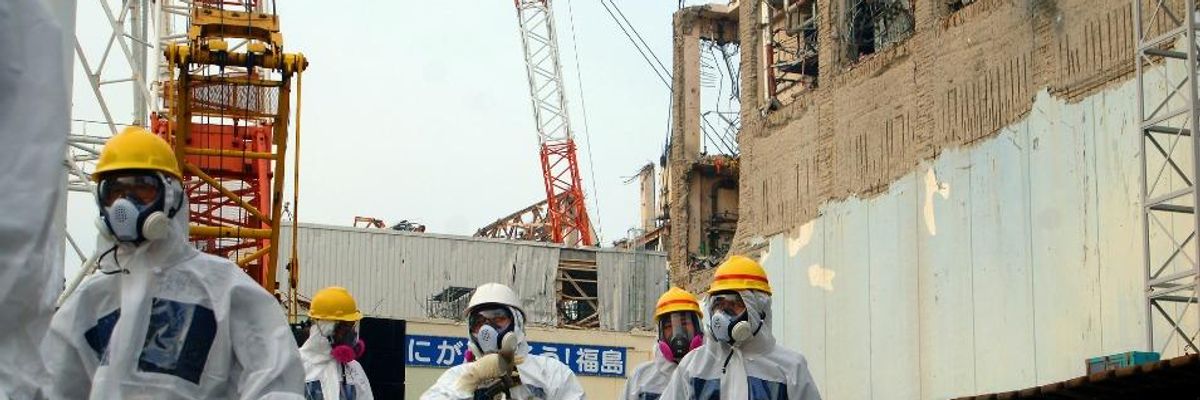Weakening radiation standards; a cap on accident liability; reactor propaganda vs improvements; old units running past expiration dates; revving the engines beyond design specs .... You'd think we were itching for a meltdown.
The Environmental Protection Agency has recommended increased radiation exposure limits following major releases. It would save the industry a bundle to permit large human exposures then, rather than shut down rickety reactors now.
The EPA proposal is a knock-off prompted by Fukushima, because after the triple meltdown started three years ago, Japan increased -- by 20 times -- the allowable radiation exposures deemed tolerable for humans. Prior to the meltdowns of March 2011, Japan allowed only 1 milliSievert of radiation per year in an individual's personal space. Now, the limit is 20 milliSieverts per year. This is not safe, it's just allowable, or, rather, affordable, since the cost of decontaminating 1,000 square miles of Japan to the stricter standard could bust the bank.
The Price Anderson Act provides US reactor owners with a liability cap and a tax-payer bailout in the event of serious accidents or attacks. The law relieves utilities of hundreds of billions in financial risk posed by our ongoing meltdown roulette game. The owners won't be bankrupted by the next loss-of-coolant disaster, but the US might.
Fukushima has spewed more long-lived radioactive chemicals to the air, the soil and the ocean than any catastrophe in history. But the chant heard round the world is: "The dose is low, there's no immediate danger." Promoters of nuclear power repeat this mantra at every opportunity, hoping to dodge Germany's answer to Fukushima -- a permanent reactor phase-out -- and it has nearly drowned out all warnings of radiation's health and environmental effects.
Have you heard of PSR's March 2011 "Health risks of the releases of radioactivity from the Fukushima reactors: Are they a concern for residents of the US?"; or IPPNW's June 2014 "Critical Analysis of the UNSCEAR Report"; or the Nov. 2012 "Report of the UN Special Rapporteur on the right to health within the context of the nuclear accident at Fukushima"; or Greenpeace's two major reports, "Lessons from Fukushima," and "Fukushima Fallout"? No, the feds would rather you read the UN Scientific Committee's exec. summary which claims Fukushima's effects are "unlikely to be observable." This conclusion was made before any research was done.
The chances of radiation disasters will increase further if the Nuclear Regulatory Commission allows US reactors to run for 80 years. This is what Duke Power, Dominion Power and Exelon suggest for seven of their 40-year-old rattle traps now operating in Pennsylvania, Virginia and South Carolina.
These seven reactors were designed and licensed to be shut down in the current decade. However, since 1991 the nuclear industry has been granted 70 "license extensions" that have generally added 20 years. Now the owners want to push their units an extra 40 years.
Former NRC Commissioner George Apostolakis wasn't apoplectic when the commission considered the idea, but, according to theNew York Times, he said, "I don't know how we would explain to the public that these designs, 90-year-old designs, 100-year-old designs, are still safe to operate." The NRC has yet to rule on the 80-year option, but it's never denied a single license extension request.
Gunning old Fukushima-type engines
Captured by the industry it's supposed to govern, the NRC has approved 149 reactor "power uprate" applications and has denied exactly one. Power uprates boost the output of old reactors beyond what their original licenses permit. It's done by packing reactor cores with extra fuel rods and, feeling lucky, running them harder.
Chillingly, 23 operating US reactors are duplicates of the Fukushima-type General Electric Mark 1. Fifteen of these clunkers have been granted power uprates, and seven of these 15 have been granted a second power uprate. (See chart) Susquehanna's two 31-year-old Fukushima clones in Pennsylvania were granted a hair-raising threepower uprates.
With the radiation industry and the NRC working to deny or delay post-Fukushima safety improvements, how do you feel about reactor operators stomping the accelerator while they run their geriatric uranium jalopies toward the cliff?

